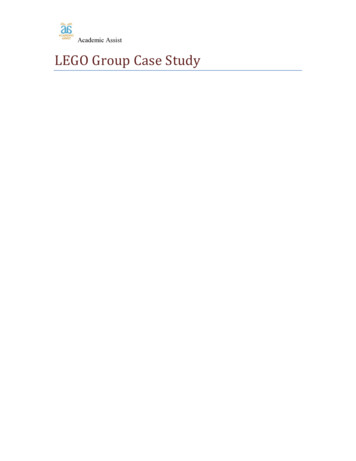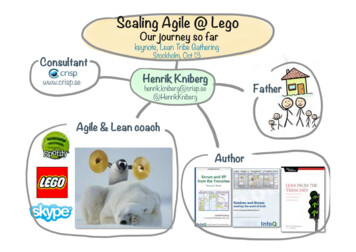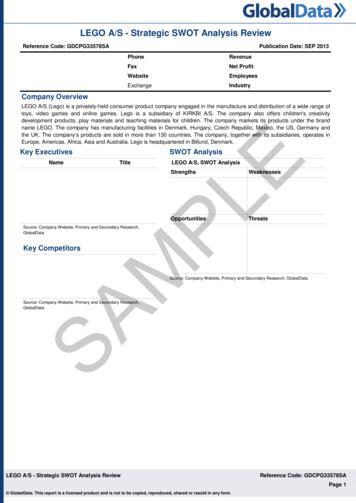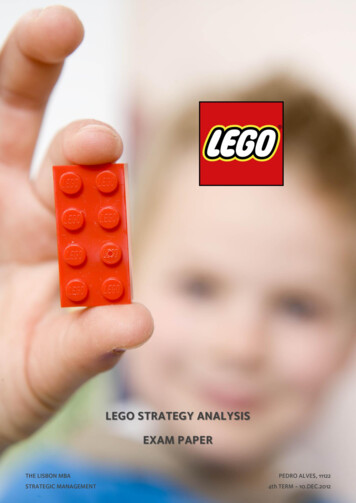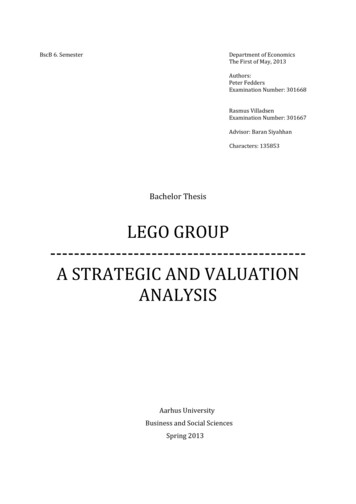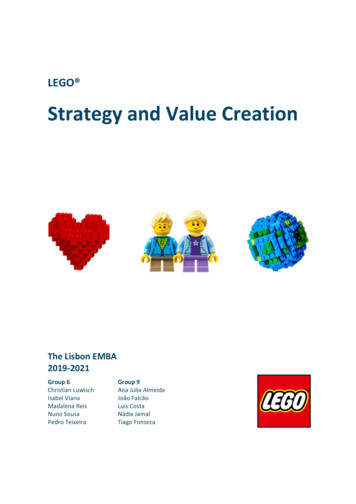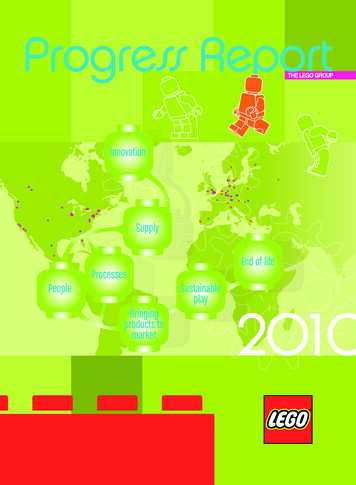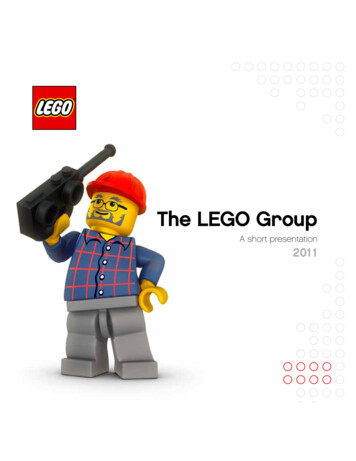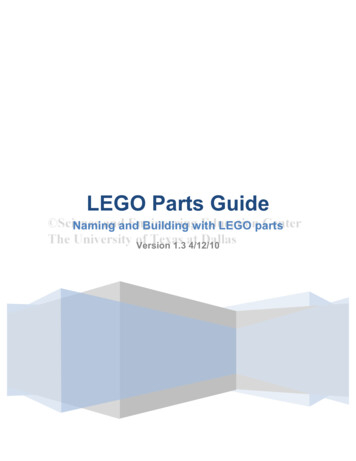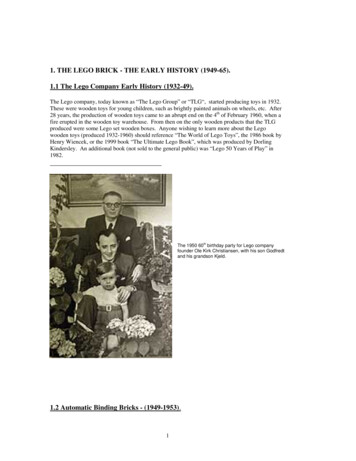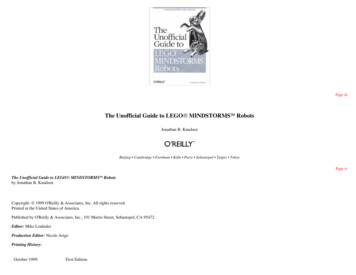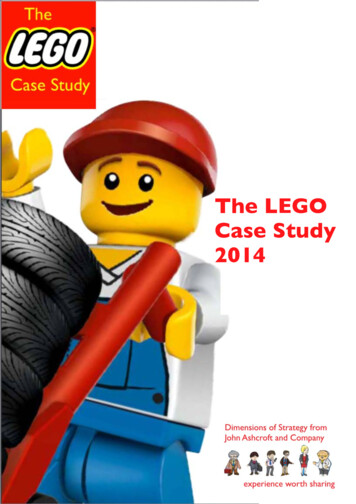
Transcription
!!!!!!!!!!!!The LEGOCase Study2014!!!!!!!!!!The A
CONTENTS !!!1!!2!!!3!!4!!5!!6!!7!!Introduction!!!!Difficult start to the decade 2001.!Signs of Recovery 2002.!Hopes dashed - 2003.!LEGOLAND parks.!LEGO Brand Stores.!The Knudstorp Review.!8!!Financial Focus - the !Oveson addition. !9!!Back to basics and the limitto adjacencies. !!!10 ! Developing the strategy !why do we exist? !!11 ! First the action plan - first!things first. !!12 ! Summary and Conclusions!!13 !Appendices !!13.1 Knudstorp on!!communication !!13.2 References and slidesThe A
1 Introduction !In 2014, LEGO announced recordresults. In the financial year 2013,revenues had increased by 10% to 25.4billion danish krona. Profits before taxwere 8.2 billion DKK. The company hadonce again delivered an impressiveoperating margin of 33% before tax.!!In US dollars, the company had achieved 4.5 billion of revenues and profits of 1.5billion. Revenues had increased from justover 1 billion some seven years earlier.LEGO had replaced Hasbro to becomethe largest toy company in the worldsecond only to Mattel. !!In just eight years, revenues at the Danishtoy manufacturer had tripled. The companyhad turned around a loss of 2.5 billionkrona in the financial years 2003 and 2004to an operating margin the envy of hightech stocks around the world.!!The transition had boosted prices andgross margins from 56% to over 70%, slashed operating costs from 70% to 37% ofturnover and doubled sales per employee. !!Return on equity had increased from zero to almost 70% and equity values had increasedfrom 400 million to over 11 billion DKK. Valued on par with NASDAQ’s Facebook, thecompany would be worth over 150 billion. Not bad for a toy company based in Denmark. !!The future had not always looked so promising. In presenting his report to management inJune 2003, Jørgen Vig Knudstorp, then head of strategic development had pulled nopunches, “We are on a burning platform, losing money with negative cash flow and a realrisk of debt default which could lead to a break up of the company”. Quite a turn around!!!How had the remarkable transition been achieved? In this case study we analyse theperformance of the company using our corporate strategy framework of analysis. We applythe same techniques to Apple [2012] and Amazon [2014]. The results are fascinating,offering comparison and contrast in the approaches used within each company.!!Check out also the Excel and Keynote Slides available as a FREE download from the site.!The Lego Case Study.com from John Ashcroft and Company, experience worth sharing. Page 3
2 Difficult start to the decade - 2001!For LEGO it hadn’t been such a great start to the decade. In2000 the company had a loss of DKK 831m, which the Chairmandescribed as “unsatisfactory”. There had been little or no growthin the year. Global net turnover was DKK 9.5 billion, compared toDKK 9.8 billion in 1999. In US dollars the company has lost 100million on revenues of around 1.2 billion.!!2000 had been a very difficult year for the entire toy industry. Butdespite many strengths and high points, the LEGO Company wasimpacted because it was believed by many, including keycustomers and management, to have lost focus.!!The LEGO Company planned to reduce or abandon certaininitiatives outside of the core business, including wristwatches,publishing and other lifestyle products. At the same time, LEGOintended to reduce losses in software and the LEGOLAND parks.!!The strategy was to refocus on the LEGO brand – stimulatingimagination, creativity and learning – “it is what children andparents expect from us. We will continue to expand within thisarea, applying a growth strategy with a huge potential and lowerrisk”. !!!More emphasis was to be placed on using leading-edgetechnologies in ways that support LEGO brand values – such asextending the “intelligent brick” concept of LEGO MINDSTORMSto open up whole new ways of playing and learning, as well asinitiatives such as LEGO Studios, putting the power ofmoviemaking in the hands of children.!New products included the “power product” programme, as well development of theTECHNIC and BASIC brands. It was believed that Bionicle, a new product with greatpotential, first launched in Europe in February 2001, would combine physical and onlineplay with LEGO story building.!!Products such as Harry Potter, Bob the Builder and Life on Mars – many of which wouldbe launched or expanded in the next year and beyond – were new concepts to providechildren with imaginative “story starters”. The product strategy - to create open-ended playscenarios with popular or fantasy characters with LEGO elements.!!!Check out also the Excel and Keynote Slides available as a FREE download from the site.!The Lego Case Study.com from John Ashcroft and Company, experience worth sharing. Page 4
Part of the growth strategy for 2001 andsubsequently would include tapping the marketpotential in the United States, Japan, the UnitedKingdom and other European countries wheremarket saturation was far from achieved. !!!!!!!!!The Chairman was anxious to assure all LEGOenthusiasts around the world the LEGO Companywas not in danger, despite a difficult financial year. !!!!!Safe in their hands !!“The LEGO brand is as strongas ever. The LEGO Companywas built upon a vision thatwe should nurture the childwithin every one of us. This isa timeless vision, and we willremain true to it and build ourfuture success upon it.” !!It all sounded very promising and so it seemed initially.!!The Lego Case Study.com from John Ashcroft and Company, experience worth sharing. Page 5
3 Signs of Recovery 2002!In 2001 the LEGO Companyreturned to profit. A pre-taxprofit of DKK 530m, comparedwell to a loss of DKK 1.07billion the year before. Profitfrom primary operations wasDKK 822m. This result wasdescribed as “satisfactory”.The 2001 result appeared tobe an obvious improvementon the previous year ’snegative performance.!!The successful result was attributed to a marked increase in sales and extensive internalchanges in areas such as production, control and the product range. “The changes havelargely been implemented – and have indeed borne fruit during the financial year.”!!Sales rose from 9.5 billion DK in 2000 to 10.7 billion DK. Higher sales to the Americanmarket were the biggest single factor behind the increase. Asia/Pacific and virtually allEuropean markets contributed to the higher level of turnover. !!As for multi channel retailing, there was also an increase in mail-order and Internet salesvia LEGO Direct. “The LEGO Company has almost completed the process of radicalchange in which it has been engaged over the past few years. The many adjustmentshave helped produce a more efficient and market-oriented organisation” claimed theChairman in the Annual Report for the year. !!“Our Company’s financial success is due primarily to the resolute effort made in manyareas. This has included a more market-responsive and focused product range, productmix, more efficient production procedures, and more targeted marketing. We havesucceeded in coming up with a product programme which has proved more attractive tothe consumer, and we have become better at reacting faster to consumer wishes.”!!“The sharp rise in sales was due especially to such product series as HarryPotter, Bob the Builder and LEGO BIONICLE"!The Lego Case Study.com from John Ashcroft and Company, experience worth sharing. Page 6
The sharp rise in sales was due especially to such product series as HarryPotter, Bob the Builder, LEGO BIONICLE and the more classic LEGOproducts – all of which contributed handsomely to the year’s result.!!!“The LEGO “Light’ Project, which brought about very far-reaching changesin our control systems, planning procedures and organisation, has alsoenabled us to respond quicker to the wishes and needs of the market.”!The Chairman warned that despite these many improvements, !”the massive boost in sales left us at times unable fully to satisfy demand inall areas. !!!!!“Not all was well in LEGOLAND as would prove to be the case inthe following year. In 2004 the LEGO Group would have to takeradical new steps to tackle its most serious financial crisis to date”. !!The Lego Case Study.com from John Ashcroft and Company, experience worth sharing. Page 7
The LEGO Group through three he Lego Case Study.com from John Ashcroft and Company, experience worth sharing. Page 8
4 Hopes dashed - 2003 !In something of an understatement, 2003 was described as a verydisappointing year for LEGO Company. Net sales fell by 26 percentfrom DKK 11.4 billion in 2002 to DKK 8.4 billion. Play material salesdeclined by 29 percent to DKK 7.2 billion.!!The result was a pre-tax loss on earnings of DKK 1.4 billion, i.e. adrop of DKK 2 billion compared with 2002. “The year’s result canonly be described as unsatisfactory. The negative developmentreflects an unsuccessful growth strategy with a consequent lossof market shares.” announced the Chairman in the Annualreport.!!At the beginning of 2003, substantial inventories of LEGOproducts, particularly in the USA, had built up within retailchannels as the 2002 Christmas sales had failed to meetexpectations. !!“By February 2003, behemoth retailers such as Target andWalmart were choking on a backlog of unsold LEGO sets.LEGO inventory had ballooned by 40% at some outlets to morethan twice the amount of stock considered to beacceptable.” [p 63 Robertson & Breen]!!As a result, LEGO sales were extremely slow at thebeginning of 2003. The downward trends continued andimpacted on the year as a whole. !!The traditional toy market stagnated in 2003, whereas thetrendier part of the market saw progress. The intensifiedcompetition in the traditional toy market resulted in a loss ofmarket share in most markets. Competitors chose to pursue astrategy of aligning themselves with LEGO Company’s productsand marketing, new trendy products emerged and retailersdeveloped own private labels products.!!The decline was particularly marked in the US where sales dropped by approximately 35percent compared to 2002. Asian markets experienced a fall of 28 percent. A significantpart of the decline in these markets was attributed to shortfalls in the sale of movie tie-inproducts. There had been no follow through on the initial Star Wars success.!!The traditional Central European markets initially performed rather well and showedstability for most of the year. !The Lego Case Study.com from John Ashcroft and Company, experience worth sharing. Page 9
Late in the year, however, sales also declined in these markets.Germany finished the year approximately 20 percent below prioryear’s level, and the UK, Holland and the Nordic markets fell by13 percent. Only the new markets in Eastern Europe anddistributor markets maintained sales on a par with prior year.!!Sales of movie tie-in products developed unsatisfactorily. Interestin the Star Wars range and, to an even greater extent, the HarryPotter series - the 2002 top seller - fell below expectations in ayear without new movie releases. The drop in sales of theseproducts accounted for more than 50 percent of the overall salesdecrease.!!!!!LEGO Company’s own BIONICLE range performed better, although sales fell by up to 20percent. Nevertheless, one of the products in the range reached the Top 10 list of the mostwanted Christmas presents in the USA. At the same time, the first BIONICLE DVD,produced in collaboration with the MIRAMAX film company, had an enthusiastic receptionin global markets.!!The sales slowdown affected LEGO Company’s product range across the board.Nevertheless, it was encouraging to note (or so it was claimed) that sales of the classicLEGO products, Make & Create, doubled and the new products for girls, CLIKITS , alsogot off to a good start. The range was discontinued in 2006.!!CLIKITS , off to a good start - it was not to last.!The Lego Case Study.com from John Ashcroft and Company, experience worth sharing. Page 10
5 LEGOLAND parks!The strategy of the LEGOLAND parks was to come under heavy scrutiny. The project wasincreasing “visibility” of the brand but was capital intensive providing limited return. Onlythe Billund site was making a significant profit. The overall result for the LEGOLAND parksin the year was on a par with 2002, although there were widely differing developmentswithin the individual parks.!!LEGOLAND Billund Denmark, ended the year with a new visitor record and increasedprofits by around 10 percent. Despite a slightly weak peak season when the park receivesnearly 40 percent of its visitors, the year finished impressively, achieving its highest evervisitor numbers for one day in the park’s 35 year history in September 2003.!!LEGOLAND Windsor UK, experienced a minor decrease in net sales due to a decliningnumber of visitors. However, turnover per visitor increased and the result was on a parwith 2002.!!LEGOLAND California USA, saw a weak start to the year, but ended the season betterthan ever before. This meant that, in terms of visitors as well as turnover, the parkachieved a result comparable to 2002 which indicates that previous years’ decline in visitornumbers appeared to have been halted.!!LEGOLAND Deutschland did not manage to avoid the “second year” effect which hadbeen noted in connection with the opening of new parks. While the year got off to a goodstart, the very hot weather in the peak season kept many visitors away. Although the hotsummer also adversely affected LEGOLAND Billund and Windsor to some extent, theconsequences for the German park were more noticeable. On some days, the number ofvisitors totalled only 60 percent compared with the same days in 2002. !!Demanding a separate skill set to the toy tradition, the parks were becoming andexpensive distraction to management and to the overall direction of the company.The Lego Case Study.com from John Ashcroft and Company, experience worth sha
despite many strengths and high points, the LEGO Company was impacted because it was believed by many, including key customers and management, to have lost focus.!! The LEGO Company planned to reduce or abandon certain initiatives outside of the core business, including wristwatches, publishing and other lifestyle products. At the same time, LEGOFile Size: 1MBPage Count: 26
